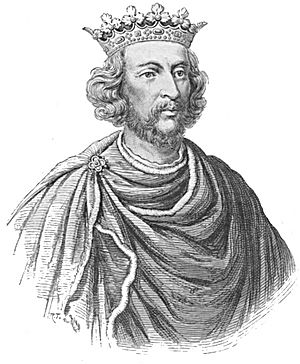Walter Giffard facts for kids
Quick facts for kids Walter Giffard |
|
|---|---|
| Archbishop of York | |
| Appointed | 15 October 1266 |
| Enthroned | 1 November 1266 |
| Reign ended | late April 1279 |
| Predecessor | Godfrey Ludham |
| Successor | William de Wickwane |
| Other posts | Bishop of Bath and Wells |
| Orders | |
| Consecration | 4 January 1265 by Peter d'Acquablanca |
| Personal details | |
| Born | c. 1225 |
| Died | April 1279 York |
| Buried | York Minster |
| Parents | Hugh Giffard Sibyl de Cormeilles |
Walter Giffard (born around 1225, died April 1279) was an important person in England during the 1200s. He held two very high positions: he was the Lord Chancellor of England and later the Archbishop of York.
Contents
Walter Giffard's Family Life
Walter Giffard was the son of Hugh Giffard and Sibyl de Cormeilles. His father, Hugh, was a royal judge. Walter was likely born around 1225 in Boyton, England.
His parents were very trusted by the king. In 1239, they were given the important job of looking after the young Prince Edward. This Prince later became King Edward I.
Walter had a brother named Godfrey Giffard. Godfrey also became a bishop and even served as Lord Chancellor, just like Walter. Walter's sister, Mabel, was the Abbess (leader) of Shaftesbury Abbey, a famous monastery for women. The Giffard family was also related to other important church leaders of their time.
Walter's Education and Early Career
Walter Giffard was a very smart student. He studied at Cambridge University and earned his Master of Arts degree from Oxford University. One of his teachers, Adam Marsh, praised Walter's excellent skills in his studies.
After his education, Walter became a priest. He held several church roles, including a canon and an archdeacon of Wells. He also served as a special chaplain to the Pope.
On May 22, 1264, Walter was chosen to be the Bishop of Bath and Wells. He officially took on this role on September 1, 1264. Because the main Archbishop of Canterbury was in France, Walter had to travel to Paris. He was made a bishop at Notre-Dame Cathedral on January 4, 1265.
Becoming Lord Chancellor and Archbishop
After a big battle called the Battle of Evesham in 1265, King Henry III made Walter Giffard his Lord Chancellor. This was a very powerful job, like being the king's chief advisor and head of the government. Walter received a large payment for this role.
In August 1266, Walter helped create an important agreement called the Dictum of Kenilworth. This agreement helped lords who had lost their lands get them back.
On October 15, 1266, Pope Clement IV chose Walter to become the Archbishop of York. This was an even higher position in the church. Because of this new role, Walter gave up his job as Lord Chancellor. He officially became Archbishop on November 1, 1266.
Life as Archbishop of York
Even though Walter Giffard came from a wealthy family and had a high-paying job, he sometimes struggled with money. He paid back large sums to lenders. However, he was very generous to his family and others.
- He paid for his nephew's education.
- He gave his brother Godfrey an important church position.
- He gave many gifts to the poor.
- He supported school teachers in Beverley.
- He also helped two future Archbishops of York, John le Romeyn and William Greenfield, with their studies.
In 1269, Walter led a special ceremony for Edward the Confessor. When Prince Edward (who would become King Edward I) left England in 1270, he trusted Walter to be one of the tutors for his sons. Walter also helped Prince Edward bring a powerful earl, John de Warenne, to justice for a crime.
When King Henry III died in 1272, Walter Giffard played a crucial role. He was one of the main leaders chosen to govern England until the new king, Edward I, returned to the country in 1274. Walter also helped govern again in 1275 when King Edward was away.
Walter Giffard's Final Years
Walter Giffard passed away in York around April 22, 1279. He was buried in York Minster, a famous cathedral. Later, another Archbishop moved his body to a special tomb.
People at the time described Walter as a handsome, happy, and friendly man. He enjoyed a comfortable life. He was known for being a person of strong character, very capable, and hardworking.


